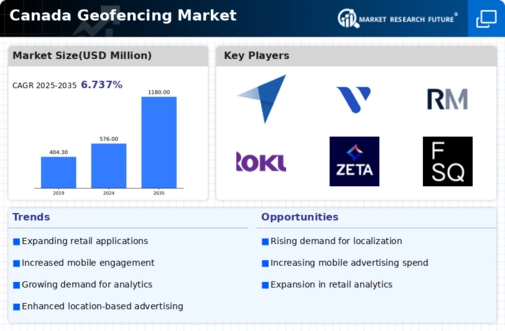Rise in Mobile Device Usage
The rise in mobile device usage among Canadians is a crucial factor propelling the geofencing market. With over 90% of the population owning smartphones, businesses are increasingly recognizing the potential of mobile technology to reach consumers in real-time. This trend is particularly relevant for industries such as retail, hospitality, and transportation, where timely notifications can influence purchasing decisions. In 2025, mobile advertising spending in Canada is projected to surpass $3 billion, indicating a strong inclination towards mobile-centric strategies. As companies adopt geofencing to capitalize on this trend, the demand for geofencing solutions is expected to surge. The ability to engage customers through their mobile devices while they are in proximity to a business location presents a unique opportunity for brands to enhance customer loyalty and drive sales, thereby significantly impacting the geofencing market.
Expansion of Location-Based Marketing
The expansion of location-based marketing strategies is a pivotal driver for the geofencing market in Canada. Businesses are increasingly leveraging geofencing technology to enhance customer engagement through targeted advertising. By utilizing geofencing, companies can send tailored promotions to consumers' mobile devices when they enter specific geographic areas. This approach not only increases foot traffic but also improves conversion rates. In 2025, it is estimated that location-based marketing expenditures in Canada will reach approximately $1.5 billion, reflecting a growth of around 20% from previous years. This trend indicates a robust demand for geofencing solutions, as businesses seek to optimize their marketing efforts and drive sales through precise targeting. As a result, the geofencing market is likely to experience significant growth fueled by this marketing evolution.
Increased Focus on Customer Experience
An increased focus on customer experience is driving the geofencing market in Canada. Businesses are recognizing that personalized interactions can significantly enhance customer satisfaction and loyalty. Geofencing technology allows companies to create tailored experiences based on a customer's location, preferences, and behavior. For instance, retailers can send exclusive offers to customers as they approach their stores, creating a sense of urgency and encouraging immediate purchases. In 2025, it is anticipated that companies investing in customer experience initiatives will allocate approximately 30% of their marketing budgets to location-based services. This shift towards prioritizing customer experience is likely to stimulate demand for geofencing solutions, as businesses seek to differentiate themselves in a competitive landscape. Consequently, the geofencing market is poised for growth as organizations increasingly adopt strategies that enhance customer engagement and satisfaction.
Advancements in Technology Infrastructure
Advancements in technology infrastructure are significantly influencing the geofencing market in Canada. The proliferation of high-speed internet and improved mobile network capabilities, such as 5G, are enabling more sophisticated geofencing applications. These technological enhancements allow for real-time data processing and more accurate location tracking, which are essential for effective geofencing solutions. As businesses seek to implement more complex and responsive marketing strategies, the demand for advanced geofencing technologies is expected to rise. In 2025, the Canadian telecommunications sector is projected to invest over $10 billion in infrastructure improvements, which will likely facilitate the growth of the geofencing market. This investment in technology not only supports the development of innovative geofencing applications but also enhances the overall user experience, making it a critical driver for market expansion.
Regulatory Support for Location-Based Services
Regulatory support for location-based services is emerging as a key driver for the geofencing market in Canada. Government initiatives aimed at promoting digital innovation and enhancing consumer protection are creating a favorable environment for geofencing technologies. Policies that encourage the responsible use of location data while ensuring user privacy are likely to foster trust among consumers. In 2025, it is expected that regulatory frameworks will evolve to better accommodate the needs of businesses utilizing geofencing, potentially leading to a 15% increase in market adoption. This supportive regulatory landscape may encourage more companies to invest in geofencing solutions, as they can operate within a clear legal framework. As a result, the geofencing market is likely to benefit from this regulatory momentum, facilitating growth and innovation in the sector.


















Leave a Comment